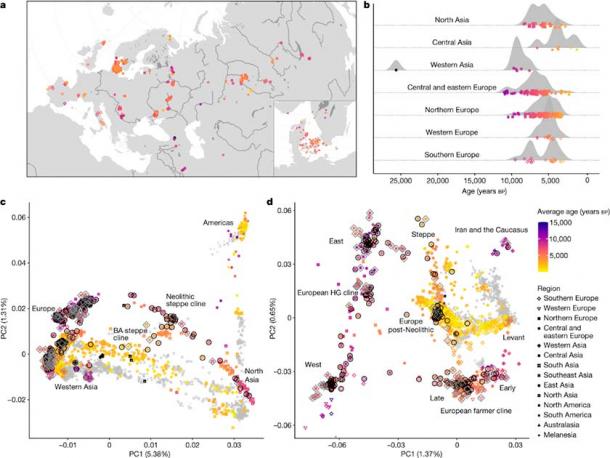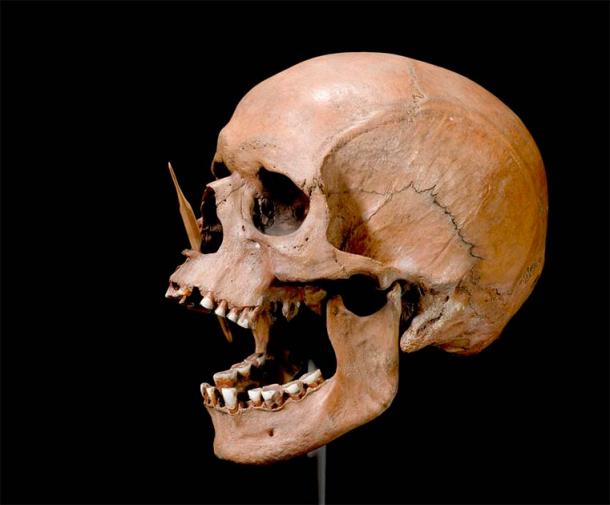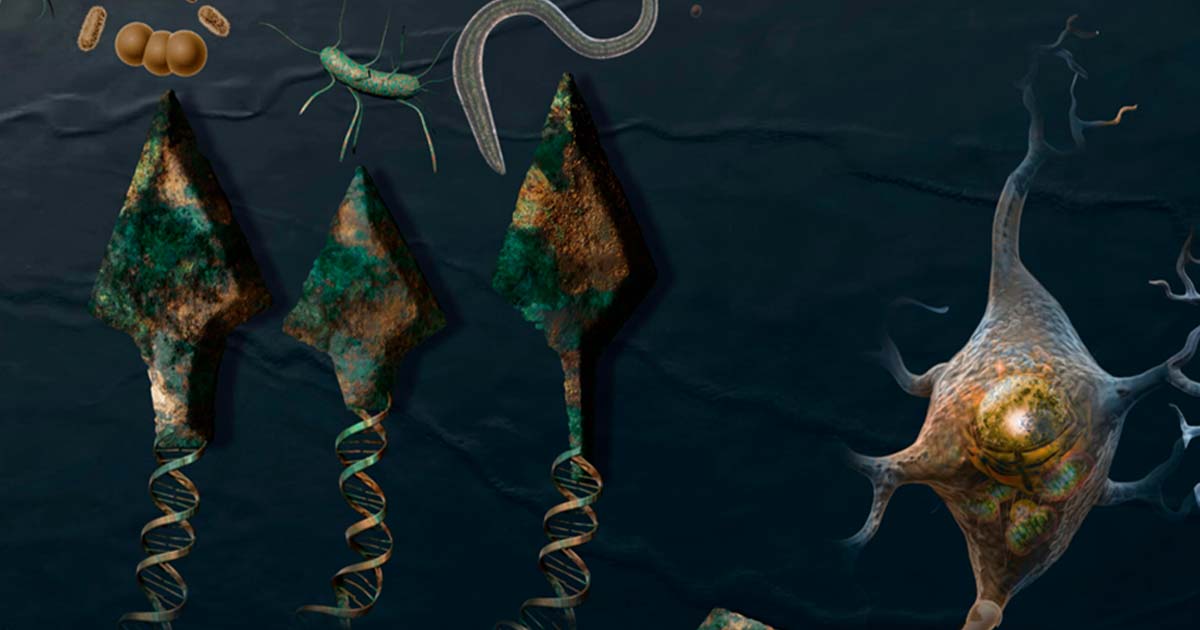Ancient DNA Reveals Reason for High Multiple Sclerosis Rates in Europe
Researchers have created the world's largest ancient human gene bank by analyzing the bones and teeth of almost 5,000 humans who lived across Western Europe and Asia up to 34,000 years ago.
By sequencing ancient human DNA and comparing it to modern-day samples, the international team of experts mapped the historical spread of genes -- and diseases -- over time as populations migrated.
The 'astounding' results have been revealed in four trailblazing research papers published 10 January 2024 in the same issue of Nature and provide new biological understanding of debilitating disorders.
The extraordinary study involved a large international team led by Professor Eske Willerslev at the Universities of Cambridge and Copenhagen, Professor Thomas Werge at the University of Copenhagen, and Professor Rasmus Nielsen at University of California, Berkeley and involved contributions from 175 researchers from around the globe.
The scientists found:
- The startling origins of neurodegenerative diseases including multiple sclerosis
- Why northern Europeans today are taller than people from southern Europe
- How major migration around 5,000 years ago introduced risk genes into the population in north-western Europe -- leaving a legacy of higher rates of MS today
- Carrying the MS gene was an advantage at the time as it protected ancient farmers from catching infectious diseases from their sheep and cattle
- Genes known to increase the risk of diseases such as Alzheimer's and type 2 diabetes were traced back to hunter gatherers
- Future analysis is hoped to reveal more about the genetic markers of autism, ADHD, schizophrenia, bipolar disorder, and depression.
Dominant Yamnaya Genes Brought Higher Risk of MS
Northern Europe has the highest prevalence of multiple sclerosis in the world. The new study has found the genes that significantly increase a person's risk of developing multiple sclerosis (MS) were introduced into north-western Europe around 5,000 years ago by sheep and cattle herders migrating from the east.
By analyzing the DNA of ancient human bones and teeth, found at documented locations across Eurasia, researchers traced the geographical spread of MS from its origins on the Pontic Steppe (a region spanning parts of what are now Ukraine, South-West Russia and the West Kazakhstan Region).
They found that the genetic variants associated with a risk of developing MS 'travelled' with the Yamnaya people -- livestock herders who migrated over the Pontic Steppe into North-Western Europe.
These genetic variants provided a survival advantage to the Yamnaya people, most likely by protecting them from catching infections from their sheep and cattle. But they also increased the risk of developing MS.
"It must have been a distinct advantage for the Yamnaya people to carry the MS risk genes, even after arriving in Europe, despite the fact that these genes undeniably increased their risk of developing MS," said Professor Eske Willerslev, jointly at the Universities of Cambridge and Copenhagen and a Fellow of St John's College, an expert in analysis of ancient DNA and Director of the project.
He added: "These results change our view of the causes of multiple sclerosis and have implications for the way it is treated."
- Neolithic Maliq Man Had Oldest Known Case of Osteopetrosis
- Researchers Diagnose Earliest Known Cancer on 1.7-Million-Year-Old Hominin Fossil

Artist's illustration symbolically depicting the research results. (Sayo Studio/Nature)
Wide Spectrum Data Sourced
The age of specimens ranges from the Mesolithic and Neolithic through the Bronze Age, Iron Age and Viking period into the Middle Ages. The oldest genome in the data set is from an individual who lived approximately 34,000 years ago.
The findings provide an explanation for the 'North-South Gradient', in which there are around twice as many modern-day cases of MS in northern Europe than southern Europe, which has long been a mystery to researchers.
From a genetic perspective, the Yamnaya people are thought to be the ancestors of the present-day inhabitants of much of North-Western Europe. Their genetic influence on today's population of southern Europe is much weaker.

Geographical and temporal distribution of the 317 ancient genomes sequenced and reported in this study. Insert shows dense sampling in Denmark34. (Allentoft, M.E., Sikora, M., Refoyo-Martínez, A. et al. /Nature
Previous studies have identified 233 genetic variants that increase the risk of developing MS. These variants, also affected by environmental and lifestyle factors, increase disease risk by around 30 percent. The new research found that this modern-day genetic risk profile for MS is also present in bones and teeth that are thousands of years old.
"These results astounded us all. They provide a huge leap forward in our understanding of the evolution of MS and other autoimmune diseases. Showing how the lifestyles of our ancestors impacted modern disease risk just highlights how much we are the recipients of ancient immune systems in a modern world," said Dr William Barrie, a postdoc in the University of Cambridge's Department of Zoology and co-author of the paper.
Multiple sclerosis is a neurodegenerative disease in which the body's immune system mistakenly attacks the 'insulation' surrounding the nerve fibers of the brain and spinal cord. This causes symptom flares known as relapses as well as longer-term degeneration, known as progression.
Professor Lars Fugger, a co-author of the MS study, professor and consultant physician at John Radcliffe Hospital, University of Oxford, said: "This means we can now understand and seek to treat MS for what it actually is: the result of a genetic adaptation to certain environmental conditions that occurred back in our prehistory."
Professor Astrid Iversen, another co-author based at the University of Oxford, said:
"We now lead very different lives to those of our ancestors in terms of hygiene, diet, and medical treatment options and this combined with our evolutionary history means we may be more susceptible to certain diseases than our ancestors were, including autoimmune diseases such as MS."
- Neolithic Revolution Spurred Mental and Physical Growth of Europeans
- Schizophrenia Emerged After Humans Diverged From Neanderthals
The Lundbeck Foundation GeoGenetics Centre -the Resource Underpinning the Discoveries
The new findings were made possible by the analysis of data held in a unique gene bank of ancient DNA, created by the researchers over the past five years with funding from the Lundbeck Foundation.
This is the first gene bank of its kind in the world and already it has enabled fascinating new insights in areas from ancient human migrations, to genetically-determined risk profiles for the development of brain disorders.
By analyzing the bones and teeth of almost 5,000 ancient humans, held in museum collections across Europe and Western Asia, the researchers generated DNA profiles ranging across the Mesolithic and Neolithic through the Bronze Age, Iron Age and Viking period into the Middle Ages.

The scientists conducted DNA sequencing on human remains preserved in museums across Europe to understand the evolution of Multiple Sclerosis. (The Danish National Museum)
They compared the ancient DNA data to modern DNA from 400,000 people living in Britain, held in the UK Biobank.
"Creating a gene bank of ancient DNA from Eurasia's past human inhabitants was a colossal project, involving collaboration with museums across the region," said Willerslev.
He added: "We've demonstrated that our gene bank works as a precision tool that can give us new insights into human diseases, when combined with analyses of present-day human DNA data and inputs from several other research fields. That in itself is amazing, and there's no doubt it has many applications beyond MS research."
The team now plans to investigate other neurological conditions including Parkinson's and Alzheimer's diseases, and psychiatric disorders including ADHD and schizophrenia.
They have received requests from disease researchers across the world for access to the ancient DNA profiles, and eventually aim to make the gene bank open access.
The research was funded by a €8M grant from the Lundbeck Foundation, and conducted at the Lundbeck Foundation Geogenetics Centre at the University of Copenhagen.
Jan Egebjerg, Director of Research at the Lundbeck Foundation, said: "The rationale for awarding such a large research grant to this project, as the Lundbeck Foundation did back in 2018, was that if it all worked out, it would represent a trail-blazing means of gaining a deeper understanding of how the genetic architecture underlying brain disorders evolved over time. And brain disorders are our specific focus area."
The article, originally titled ‘Ancient DNA reveals reason for high multiple sclerosis and Alzheimer's rates in Europe’ was first published on Science Daily.
Source: University of Cambridge. "Ancient DNA reveals reason for high multiple sclerosis and Alzheimer's rates in Europe." ScienceDaily. ScienceDaily, 10 January 2024. www.sciencedaily.com/releases/2024/01/240110120200.htm
Top image: Artist's illustration symbolically depicting the research results. Source: Sayo Studio/Nature
References
William Barrie et al. Elevated genetic risk for multiple sclerosis emerged in steppe pastoralist populations. Nature, 2024; 625 (7994): 321 DOI: 10.1038/s41586-023-06618-z

















Comments
"This means we can now understand and seek to treat MS for what it actually is: the result of a genetic adaptation to certain environmental conditions that occurred back in our prehistory."
The link between vaccination and diseases like MS will never be studied. Sure, genetics are important in MS. Uncoincidentally, genetics are the keys to bioweapon development.
Whomsoever thinks bioweapons are outlawed and, therefore, don't exist is perfect fodder for them.